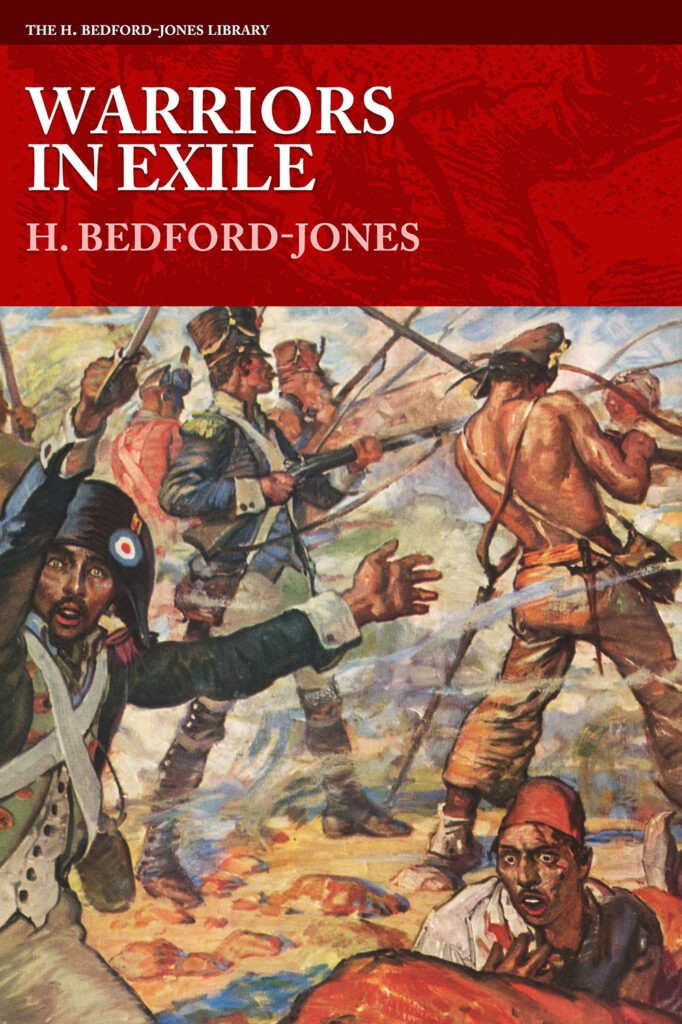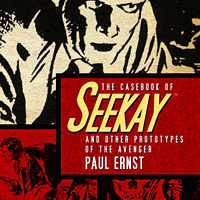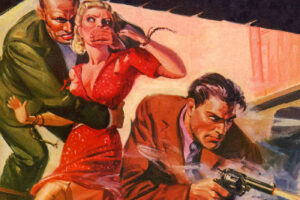Warriors in Exile is another of the “King of Pulps” H. Bedford-Jones’s (1887-1949) multi-part historical-fiction series reprinted by Steeger Books in their H. Bedford-Jones Library.
 The series focuses on the French Foreign Legion with several fictional stories based on its history. It ran for 17 installments in Blue Book from June 1937-October 1938. The cover art is taken from the cover the June 1937 issue to announce the start of the series. The artwork is by Herbert Morton Stoops, who did all the Blue Book covers from 1935 to 1948. We also get all the pen-and-ink artwork that illustrated all the stories. Per Galactic Central, these were by Jeremy Cannon.
The series focuses on the French Foreign Legion with several fictional stories based on its history. It ran for 17 installments in Blue Book from June 1937-October 1938. The cover art is taken from the cover the June 1937 issue to announce the start of the series. The artwork is by Herbert Morton Stoops, who did all the Blue Book covers from 1935 to 1948. We also get all the pen-and-ink artwork that illustrated all the stories. Per Galactic Central, these were by Jeremy Cannon.
Almost all the stories are narrated by an unknown narrator (implied as being Bedford-Jones), and convey a fictionalized account of events from what are meant to be real individuals. This is what gives these stories impact: they all focus on the actions of one or two characters, only some of whom are historical. In the first story, we are introduced to a trio of former Legionnaires: red-haired Irishman Casey, Kramer, and Alsatian Ponson. They figure in many of the segments, though not all.
“We, About to Die” kicks things off with our narrator and the trio of Casey, Kramer, and Ponson. They are arguing about the origin of the Legion, when Ponson tells a story of his grandfather’s grandfather, who was a colonel under General Kleber in Egypt. French forces are in a tight spot threatened by a larger Turkish force that wants to wipe them out, and blocked by the English Navy. So we get a first-hand account of the fighting where the French forces overwhelmed the Turks. Colonel Ponson leads a force of foreigners fighting for France, which could have become the first French Foreign Legion but didn’t due to the assassination of Kleber.
“A Touch of Sun” brings back the trio, joined by another Legionnaire: Falkenstein. He has in his possession a journal written by a past Legionnaire and tells the story of Pan Andrei, a Polish prince who had joined the Legion after being defeated in rebellion against the Russians. But then in Algiers, he goes a little crazy from the sun, deserts and joins with the Arab rebels, taking a Turkish wife. What does become of him?
In “The Legion in Spain,” our narrator, led by a local, is getting out of Spain during the Civil War. This local then related the story of his father. He had left Spain over a quarrel over a girl and joined the Legion. But the Legion was given over to Queen Isabella to fight the Carlists and he finds himself back in his home village, though no one remembers him. He meets up with his former love and his younger brother, who does not recognize him. What happens next? And who is the dreaded El Picador?
Our trio of Legionnaires is back to tell us another tale in “The Grandson of Pompey.” It’s set in Miliana, a town south of Algiers, and concerns a man who is made an honorary Legionnaire. He was an old English lord referred to as Milord Pompey because he was obsessed with finding the grave of the grandson of Pompey. There is some connection between him and a Private Smeeth. And you learn what it is and how the story title has a double meaning.
It’s Casey and Kramer this time, though it is Casey who tells us about the Legion in 1856 during the Crimean War in “Leather-Bellies in the Crimea.” And it’s a strange tale, as Casey is telling of his uncle who had served in the Legion at the time, but had deserted and joined the Cossacks. He meets his uncle while Casey is in Crimea fighting the Russians during the Russian Civil War.
Kramer by himself tells us the story of “Life, Not Courage, Left Them,” about the Legion in Mexico fighting for Emperor Maximillian. In particular, it’s about a certain Legionnaire named Victor. You will learn at the end how he is connected to Kramer.
“The First American to Fight in the Legion” is given as a whole fictional tale. It centers around a couple of former Union soldiers, Ellis Clarke and Bill Hicks, now in Mexico fighting against Maximillian after the U.S. Civil War. The French Foreign Legion is there fighting for Maximillian. Along the way, the two encounter a unit of Legionnaires under the leadership of Jim Faber. Who is really Jim Clarke, the brother of Ellis? What happens between these men?
Ponson is with our narrator at the cafe when a waiter tells them a tale of Legion in Italy, centered around a man named Basseti in “One Night in Magenta.”
Our narrator, in “Dust of Dead Souls,” is in Algiers shortly after the Hindenburg crashed when he meets a veteran from the Franco-Prussian War, a Colonel Wiart, and is told a story of that war when he was a sergeant.
Next, our narrator is in Yuma, Ariz., and bails a former Legionnaire out of jail, who travels east with him. Doing so he related a story about his close comrade in Tonkin in “A Crown Is Earned.”
Our trio of Legionnaires and several others are gathered at a cafe. Ponson tells of Papa Weber and his actions in Formosa in “The Crime of the Legion.”
In “Fighting Through,” our narrator is in California working on his date plantation. For those not aware, Bedford-Jones owned and ran a date plantation for many years. One of his recent workers arrives early, known only as “Dad,” and they happen to talk about the Legion. Turns out Dad had been in the Legion and tells of a desperate time in Tonkin.
This time our narrator is in Westminster Cathedral when he runs into an old acquaintance, a former Legionnaire, Pierre Dupre. He tells of the Legion in Siam in “Gentleman Royal.”
Our narrator again joins a group of Legion veterans where he is introduced to one, Wetzler, who relates in “The King’s Pipe,” a story of the Legion in Dahomey in 1892 when they were the bodyguard to the king.
In “The Little Black God,” our narrator is in the Brittany site of Saint-Malo (here rendered St. Malo) when he witnesses the funeral of a Doctor Bistertt. Returning a few months later, he visits a shop in a nearby village selling items owned by the doctor. In particular, he shows the narrator a Sudanese fetish the doctor obtained while serving in the Legion as a medic stationed in Sudan. And how would the shopkeeper know about this?
A new trio of Legion veterans are complaining about a horrible book on the Legion in “Reilly of the Legion,” when one of the relates the tale of the title character’s service in Madagascar.
In the final story, “A Devil in the Heart,” our narrator is traveling in the American Southwest when he picks up a hitchhiker. The hitchhiker tells him a tale of the Legion in the Sahara, of someone he knew once. You’ll figure out the truth toward the end.
Like all of Bedford-Jone’s historical fiction, these are all rousing tales. You could jump around, reading them in any order. I choose to read each one in order, but took my time, reading other works in between.
Steeger Books has reprinted several of these series from Blue Book and I hope they do all of them. I have yet to read one of these by Bedford-Jones that I didn’t enjoy.



